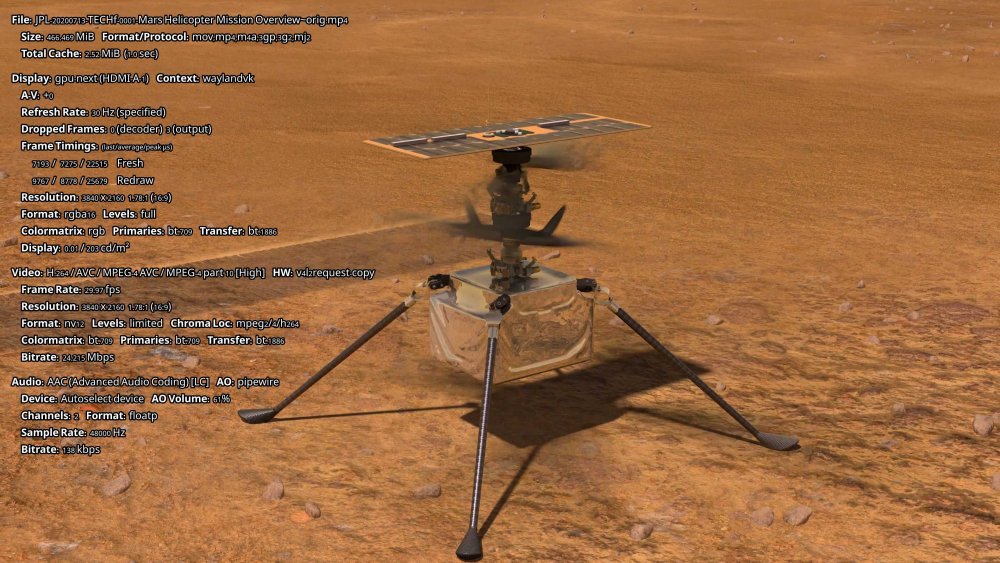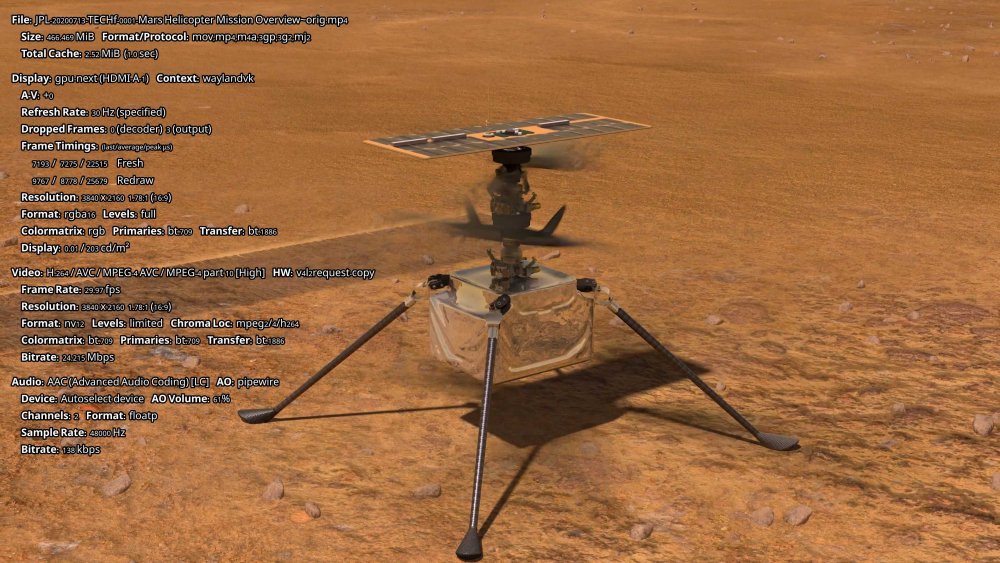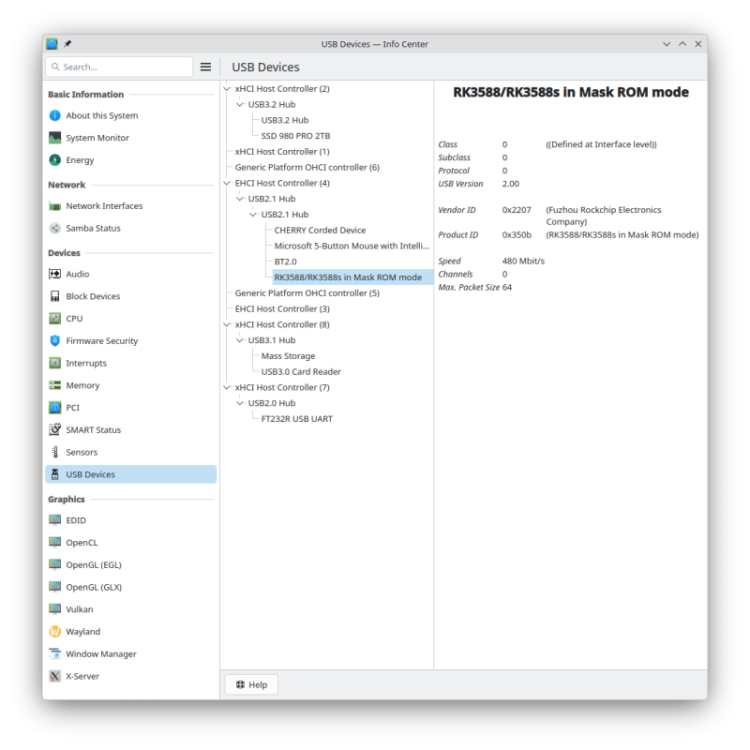
usual user
-
Posts
515 -
Joined
-
Last visited
Content Type
Forums
Store
Crowdfunding
Applications
Events
Raffles
Community Map
Posts posted by usual user
-
-
3 hours ago, gpupoor said:
I haven't been able to figure out how you got there.
I don't really do anything special. Since the architecture of the devices I use is quite up-to-date, development for their support is also at the bleeding edge. It is therefore also of essential importance to use the latest software releases. My chosen distribution provides me with this quite promptly. But that's where it ends. I receive no support at all for using my devices there. She doesn't even provide me with firmware for my devices to start the system.
The kernel provided by my distribution is only the one based on the currently released mainline source code. So if I want to use functionalities whose development is still in progress, I have to build the kernel myself with the appropriate patches, which I do regularly (E.g., I'm just building one so I can play around with RGA3).
I haven't done much work in user space for a long time, but recently I've been building the FFmpeg package myself again since the availability of RKVDEC2. v4l-request works out-of-the-box with the GStreamer framework, but for FFmpeg, it will probably take some time until support is available in a release version.OK, the kernel is done. Now I have to deal with another video device:
lrwxrwxrwx 1 root root 12 Dec 7 22:44 platform-fdb50000.video-codec-video-index0 -> ../../video3 lrwxrwxrwx 1 root root 12 Dec 7 22:44 platform-fdb60000.rga-video-index0 -> ../../video2 lrwxrwxrwx 1 root root 12 Dec 7 22:44 platform-fdb80000.rga-video-index0 -> ../../video0 lrwxrwxrwx 1 root root 12 Dec 7 22:44 platform-fdba0000.video-codec-video-index0 -> ../../video4 lrwxrwxrwx 1 root root 12 Dec 7 22:44 platform-fdc38100.video-codec-video-index0 -> ../../video1 lrwxrwxrwx 1 root root 12 Dec 7 22:44 platform-fdc70000.video-codec-video-index0 -> ../../video5 -
FWIW, on my rk3588 devices the NPUs are working with recent mainline releases:
[ 5.967316] [drm] Initialized rocket 0.0.0 for rknn on minor 0 [ 5.975499] rocket fdab0000.npu: Rockchip NPU core 0 version: 1179210309 [ 5.978652] rocket fdac0000.npu: Rockchip NPU core 1 version: 1179210309 [ 5.985602] rocket fdad0000.npu: Rockchip NPU core 2 version: 1179210309This script runs the Mesa example with the latest available working versions:
Spoiler#!/bin/bash IMAGE="grace_hopper.bmp" WORKBENCH="." ENVIRONMENT="${WORKBENCH}/python/3.11" [ "${1}" == "setup" ] || [ ! -f ${ENVIRONMENT}/bin/activate ] && BOOTSTRAP="true" [ -v BOOTSTRAP ] && python3.11 -m venv ${ENVIRONMENT} source ${ENVIRONMENT}/bin/activate [ -v BOOTSTRAP ] && pip install numpy==1.26.4 [ -v BOOTSTRAP ] && pip install pillow==12.0.0 [ -v BOOTSTRAP ] && pip install tflite-runtime==2.14.0 TEFLON_DEBUG=verbose ETNA_MESA_DEBUG=ml_dbgs python ${WORKBENCH}/classification-tflite.py \ -i ${WORKBENCH}/${IMAGE} \ -m ${WORKBENCH}/mobilenet_v1_1_224_quant.tflite \ -l ${WORKBENCH}/labels_mobilenet_quant_v1_224.txt \ -e /usr/lib64/libteflon.so deactivateAnd with this script, the Mesa example runs, with a small adjustment, also with the TFLite successor LiteRT:
Spoiler#!/bin/bash IMAGE="grace_hopper.bmp" WORKBENCH="." ENVIRONMENT="${WORKBENCH}/python/3.13" [ "${1}" == "setup" ] || [ ! -f ${ENVIRONMENT}/bin/activate ] && BOOTSTRAP="true" [ -v BOOTSTRAP ] && python3.13 -m venv ${ENVIRONMENT} source ${ENVIRONMENT}/bin/activate [ -v BOOTSTRAP ] && pip install pillow [ -v BOOTSTRAP ] && pip install ai-edge-litert-nightly TEFLON_DEBUG=verbose ETNA_MESA_DEBUG=ml_dbgs python ${WORKBENCH}/classification-litert.py \ -i ${WORKBENCH}/${IMAGE} \ -m ${WORKBENCH}/mobilenet_v1_1_224_quant.tflite \ -l ${WORKBENCH}/labels_mobilenet_quant_v1_224.txt \ -e /usr/lib64/libteflon.so deactivateA MediaPipe sample can also be set up easily:
Spoiler#!/bin/bash WORKBENCH="." ENVIRONMENT="${WORKBENCH}/python/3.12" [ "${1}" == "setup" ] || [ ! -f ${ENVIRONMENT}/bin/activate ] && BOOTSTRAP="true" [ -v BOOTSTRAP ] && python3.12 -m venv ${ENVIRONMENT} source ${ENVIRONMENT}/bin/activate [ -v BOOTSTRAP ] && pip install mediapipe [ -v BOOTSTRAP ] && pip install pillow [ -v BOOTSTRAP ] && pip install ai-edge-litert-nightly python ${WORKBENCH}/detect.py --model efficientdet_lite0.tfliteBut unfortunately, the MediaPipe framework does not support the extended delegate functionality of LiteRT (TFLite).
And therefore no NPU support.classification-3.11-tflite.logclassification-3.13-litert.logobject_detection-3.12-litert.log
-
5 hours ago, c0rnelius said:
Yeap. One fixes topology and the other pcie performance.
It works for me without the DT fix as well, but PCIe doesn't work for me at all, even with the referenced patch.
But I suppose it's because the device discussed in this thread doesn't have any PCIe hardware support at all. -
4 hours ago, Mark Umina said:
May I ask where to retrieve `idbloader.img`?
`idbloader.img` is device-specific code that is created from firmware build artifacts with U-Boot as payload using proprietary tools available only in binary form.
SBC providers rarely offer ready-to-use code.
I therefore prefer to load my firmware from microSD cards.
Since it has apparently become increasingly common lately to provide only the MASKROM mode as the sole reliable recovery method, I have started building my firmware for Rockchip devices as RAM images as well. I can then simply upload them using MASKROM mode and start my work from there without having to rely on proprietary, binary-only tools. -
10 hours ago, iav said:
What could be the reason?
Is see no significant differences:
******************************************************************************** ssd-006 Hardkernel ODROID-N2Plus CPU 0-1: performance 1000 MHz - 2016 MHz CPU 2-5: performance 1000 MHz - 2400 MHz GPU: performance 124 MHz - 799 MHz 6.16.0-0.rc1.17.fc43.aarch64 #1 SMP PREEMPT_DYNAMIC Sat Jun 14 11:19:02 CEST 2025 ******************************************************************************** 7z b 7-Zip 24.09 (arm64) : Copyright (c) 1999-2024 Igor Pavlov : 2024-11-29 64-bit arm_v:8-A locale=en_US.UTF-8 Threads:6 OPEN_MAX:1024 Compiler: ver:15.2.1 20250924 (Red Hat 15.2.1-2) GCC 15.2.1 : UNALIGNED Linux : 6.16.0-0.rc1.17.fc43.aarch64 : #1 SMP PREEMPT_DYNAMIC Sat Jun 14 11:19:02 CEST 2025 : aarch64 PageSize:4KB THP:madvise hwcap:8FF:CRC32:SHA1:SHA2:AES:ASIMD arm64 1T CPU Freq (MHz): 2092 2387 2384 2390 2361 2389 2388 3T CPU Freq (MHz): 282% 2239 296% 2352.. 6T CPU Freq (MHz): 538% 2040 497% 1893.. RAM size: 3740 MB, # CPU hardware threads: 6 RAM usage: 1334 MB, # Benchmark threads: 6 Compressing | Decompressing Dict Speed Usage R/U Rating | Speed Usage R/U Rating KiB/s % MIPS MIPS | KiB/s % MIPS MIPS 22: 7107 508 1362 6914 | 141426 488 2473 12058 23: 6459 494 1332 6581 | 136949 489 2421 11847 24: 6268 508 1327 6740 | 132118 485 2390 11593 25: 5695 515 1264 6503 | 127085 483 2343 11310 ---------------------------------- | ------------------------------ Avr: 6382 506 1321 6684 | 134394 486 2407 11702 Tot: 496 1864 9193******************************************************************************** ssd-006 Hardkernel ODROID-N2Plus CPU 0-1: performance 1000 MHz - 2016 MHz CPU 2-5: performance 1000 MHz - 2400 MHz GPU: performance 124 MHz - 799 MHz 6.18.0-0.rc3.30.fc44.aarch64 #1 SMP PREEMPT_DYNAMIC Mon Oct 27 21:17:35 CET 2025 ******************************************************************************** 7z b 7-Zip 24.09 (arm64) : Copyright (c) 1999-2024 Igor Pavlov : 2024-11-29 64-bit arm_v:8-A locale=en_US.UTF-8 Threads:6 OPEN_MAX:1024 Compiler: ver:15.2.1 20250924 (Red Hat 15.2.1-2) GCC 15.2.1 : UNALIGNED Linux : 6.18.0-0.rc3.30.fc44.aarch64 : #1 SMP PREEMPT_DYNAMIC Mon Oct 27 21:17:35 CET 2025 : aarch64 PageSize:4KB THP:madvise hwcap:8FF:CRC32:SHA1:SHA2:AES:ASIMD arm64 1T CPU Freq (MHz): 2365 2380 2383 2390 2389 2391 2388 3T CPU Freq (MHz): 277% 2162 274% 2095.. 6T CPU Freq (MHz): 533% 2021 508% 1926.. RAM size: 3737 MB, # CPU hardware threads: 6 RAM usage: 1334 MB, # Benchmark threads: 6 Compressing | Decompressing Dict Speed Usage R/U Rating | Speed Usage R/U Rating KiB/s % MIPS MIPS | KiB/s % MIPS MIPS 22: 6924 491 1373 6737 | 136783 473 2465 11662 23: 6586 495 1356 6711 | 141391 506 2418 12232 24: 6240 494 1359 6709 | 138310 510 2382 12137 25: 5912 507 1330 6750 | 127792 487 2337 11373 ---------------------------------- | ------------------------------ Avr: 6415 497 1355 6727 | 136069 494 2401 11851 Tot: 495 1878 9289 -
1 hour ago, gpupoor said:
Making some assumptions... you're 6.18 + Mesa 25.3 + Teflon delegate for the TensorFlow Lite tests?
Right, I always use the same system with all my devices. Makes comparisons more meaningful. Only the loaded DT is the only difference.
-
10 hours ago, gpupoor said:
Kernel matters - NPU only works on 6.1 vendor kernel. Mainline 6.12 has no NPU support but best GPU drivers.
I have nothing to complain about and the VPUs are also working.
-
28 minutes ago, XFer012 said:
my NVMe drive was limited to 400 MB/s
What do you expect from single lane M.2 PCIe2.0?
-
1 hour ago, gpupoor said:
I understand that panthor is not supported for wayland
I have nothing to complain about.
-
1 hour ago, specs said:
To run mesa 25.3 with Debian you'll have to install mesa using source-packages.
I was just about to rebuild the source package, but today's upgrade delivered everything turnkey since my development team was faster and had done everything for me.
The previously referenced description does provide a working result, but it does not use the most current available releases. This script runs the NPU with the latest working releases:#!/bin/bash WORKBENCH="." python3.11 -m venv ${WORKBENCH}/python/3.11 source ${WORKBENCH}/python/3.11/bin/activate pip install numpy==1.26.4 pip install pillow==12.0.0 pip install tflite-runtime==2.14.0 TEFLON_DEBUG=verbose ETNA_MESA_DEBUG=ml_dbgs python ${WORKBENCH}/classification.py \ -i ${WORKBENCH}/grace_hopper.bmp \ -m ${WORKBENCH}/mobilenet_v1_1_224_quant.tflite \ -l ${WORKBENCH}/labels_mobilenet_quant_v1_224.txt \ -e /usr/lib64/libteflon.so deactivate -
-
2 hours ago, robertoj said:
i am not trying to backport it.
Official development for inclusion in upstream are carried out by working on the project's main branch.
That's exactly what this pull request branch does by tracking the project's master tree.
Applying commits to anything else is backporting.2 hours ago, robertoj said:I want to make it work in trixie.
Backporting is possible, but you will have to deal with the consequences yourself that arise from your outdated versions lacking the functions required for your backport, and you may need to backport those as well.
Since this project is a user program and not a framework with libraries that other programs depend on, it is solely the user who has to deal with it as a dependency in its use.
At first, I also tried to use the sources of the current release version as a base, but since the commits couldn't be applied without errors, I simply built the current master branch.
For the FFMPEG framework, this is already a whole different ballgame. There are many programs, which mpv is just one, that depend on the libraries and need to be rebuilt accordingly in case of an upgrade.
Since my chosen distribution recently released ffmpeg 8.0 and thus made all dependent programs available accordingly, I just had to rebuild the ffmpeg package with the v4l2request support commits and put that in place. And since the commits could be applied to the current release sources without any errors, I didn't even need to switch to the master branch. -
4 hours ago, robertoj said:
Then rebuild mpv+PR14690
Just out of curiosity, why are you trying to backport the v4l2request support?
Why not build the pull request tree directly:git clone --branch v4l2request https://github.com/philipl/mpv.git mpv-player-v4l2request -
49 minutes ago, xNiux said:
It need patched kernel recompilation.
The 6.18.0-rc5 kernel doesn't require any patches, just have to been build with DRM_ACCEL_ROCKET.
-
-
3 hours ago, xNiux said:
what could be the effect on the system ?
I have that line also:
[ 0.496136] rockchip-pm-domain fd8d8000.power-management:power-controller: Failed to enable supply: -517 [ 0.938478] rockchip-pm-domain fd8d8000.power-management:power-controller: Failed to create device link (0x180) with supplier 2-0042 for /power-management@fd8d8000/power-controller/power-domain@8 [ 1.224290] rockchip-pm-domain fd8d8000.power-management:power-controller: Failed to enable supply: -517 [ 1.237338] rockchip-pm-domain fd8d8000.power-management:power-controller: Failed to create device link (0x180) with supplier 2-0042 for /power-management@fd8d8000/power-controller/power-domain@8 [ 1.294276] rockchip-pm-domain fd8d8000.power-management:power-controller: Failed to create device link (0x180) with supplier spi2.0 for /power-management@fd8d8000/power-controller/power-domain@12 [ 17.384495] rockchip-pm-domain fd8d8000.power-management:power-controller: sync_state() pending due to fdba4000.video-codec [ 17.385477] rockchip-pm-domain fd8d8000.power-management:power-controller: sync_state() pending due to fdba8000.video-codec [ 17.386457] rockchip-pm-domain fd8d8000.power-management:power-controller: sync_state() pending due to fdbac000.video-codec [ 17.387427] rockchip-pm-domain fd8d8000.power-management:power-controller: sync_state() pending due to fdc40100.video-codecBut VPU seems to be working anyway:
-
3 hours ago, xNiux said:
Do you know if the access to Rockchip NPU is OK ?
If wired correctly, dmesg reveals the following:
[ 5.967316] [drm] Initialized rocket 0.0.0 for rknn on minor 0 [ 5.975499] rocket fdab0000.npu: Rockchip NPU core 0 version: 1179210309 [ 5.978652] rocket fdac0000.npu: Rockchip NPU core 1 version: 1179210309 [ 5.985602] rocket fdad0000.npu: Rockchip NPU core 2 version: 1179210309And when mesa is built with the rocket driver enabled, it can be used via teflon.
-
FWIW, HEVC support is queued for 6.19.
With WIP patches on top, rkvdec2 is also available to me. With the gstreamer framework, this works for me out-of-the-box, as the necessary support has been available in mainline for quite some time. See video-pipeline.pdffor reference.
I have already rebuilt the Huffman package with the patches mentioned above, but currently the developers of the distribution of my choice are busy rebuilding all packages that depend on it. As soon as the Huffman package is rolled out, I will start to see how HEVC performs with the FFMPEG framework.
-
23 minutes ago, eselarm said:
I also don't know how to create 'hidden' text files so no endless logs or so.
Drop it in a Spoiler:

-
53 minutes ago, BlackS said:
And maybe it can be helpful. I can see on my UART console only this
And since it contains no firmware payload output, no one can tell what you are running.
-
2 hours ago, eselarm said:
Below is what I get on a NanoPi-R6C (RK3588s, Trixie). You can see only JPEG encoder is available.
My rk3588 devices are e.g. exposing this:
And here is the visualization of a video pipeline: video-pipeline.pdf
Watch out for the v4l2slh265dec component.
-
30 minutes ago, schunckt said:
I know there are a bunch of threads here and elswhere in the web but most are outdated, dealing with vaapi or other stuff, but I want to stay on v4l2 which seems to be the future.
https://lore.kernel.org/linux-media/Z4e9wNxZjvnytXlL@pengutronix.de/
-
-
1 hour ago, roastmeat said:
I can boot without any drives (uSD card), and sometimes with one drive but never with two.
Out of curiosity, does it work if you drop my firmware build in place?
dd bs=512 seek=1 conv=notrunc,fsync if=u-boot-meson.bin of=/dev/${entire-device-to-be-used}




Expected default graphics acceleration for RK3588?
in Orange Pi 5 Plus
Posted
That's not really possible either. The only thing that is possible is using my kernel build in Armbian environment to see how it is performing for you. With my jumpstart image, this is actually quite easy to implement.
For this, both root filesystems just need to be mounted and
extlinux/prepare-jump-start ${target-rootfs-mount-point}needs to be executed in the jumpstart rootfs.
If the target system is now being booted with firmware that uses mainline U-Boot as the payload, nothing stands in the way of booting with my kernel.
And don't worry, prepare-jump-start only adds files to the target rootfs. Nothing will be overwritten or deleted.
If you want to give it a whirl, speak up and I will upload a current image.
But you will be disappointed, because the stock kernel only provides the functionalities available with the officially released kernel. Both Armbian and my kernel build have already applied patches that may appear in a future official release.
I doubt that you will succeed, because even the fedora organization only does a full rebuild once per release cycle. There is no advantage in rebuilding a component unmodified that leads to the same result as the package already provided. It only makes sense to do this when branching off the release version in order to create a synchronized basis for further development.
Only modified packages will be replaced or upgraded. My weekly upgrade gives me several gigabytes of new packages each time because I'm on Rawhide. Somehow, I can no longer manage to stick to any official release versions.